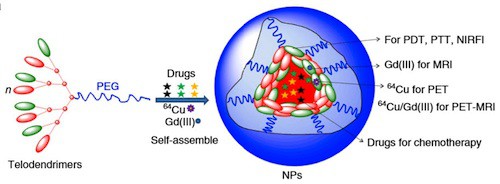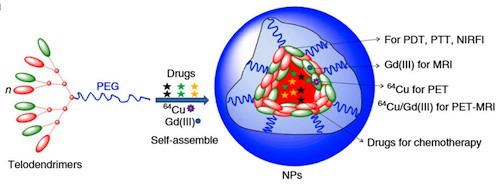
A variety of nanoparticles have been designed for multiple nanomedical purposes. An article at KurzweilAI.net presents news from UC Davis of a “nanoporphyrin” platform for developing multifunctional nanoparticles based upon treelike dendrimer structures made using porphyrin, cholic acid, amino acids, and polyethylene glycol “A multifunctional medical nanoparticle“:
Researchers at UC Davis Comprehensive Cancer Center and other institutions have created biocompatible multitasking nanoparticles that could be used as contrast agents to light up tumors for MRI and PET scans or deliver chemo and other therapies to destroy tumors. The study was published online in Nature Communications [abstract].
“These are amazingly useful particles,” noted co-first author Yuanpei Li, a research faculty member in the Lam laboratory. “As a contrast agent, they make tumors easier to see on MRI and other scans. We can also use them as vehicles to deliver chemotherapy directly to tumors, apply light to make the nanoparticles release singlet oxygen (photodynamic therapy), or use a laser to heat them (photothermal therapy) — all proven ways to destroy tumors.”
Jessica Tucker, program director of Drug and Gene Delivery and Devices at the National Institute of Biomedical Imaging and Bioengineering, which is part of the National Institutes of Health, said the approach outlined in the study has the ability to combine both imaging and therapeutic applications in a single platform, which has been difficult to achieve, especially in an organic, and therefore biocompatible, vehicle. …
The basic nanoparticles are 21 nm in diameter—32 nm if stabilized by cross-linking with the amino acid cysteine. This is an ideal size to penetrate tumors while sparing healthy tissue. the team has tested the nanoparticles both in the lab and in animals for a variety of tasks, ranging from staying intact in blood for many hours without releasing their payload until exposed to the appropriate physical or chemical signal, to serving as optical probes for image-guided surgery. A few additional details are provided by coverage at Phys.org “New cancer-hunting ‘nano-robots’ to seek and destroy tumours“. With so many nanoparticle architectures under development for various nanomedical tasks, we can only hope that clinical tests are conducted as soon as possible to determine what actually works in patients.
—James Lewis, PhD
